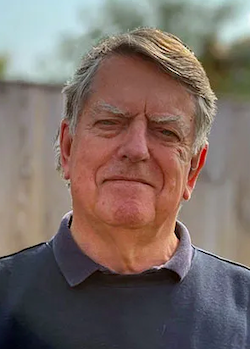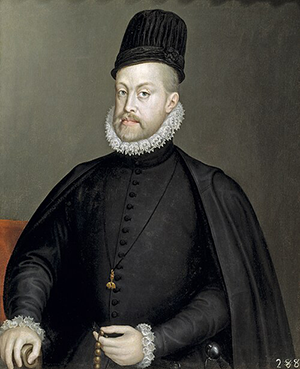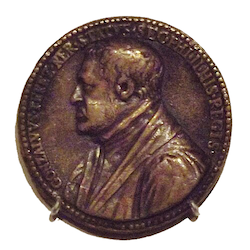Life After Chase: Ronald Munro Watt
Q&A with Author of New Historical Novel,Gonzalo Pérez and King Philip of England and Spain

Ronald Munro Watt – who last wrote for this website about his experiences as Country Manager in Pakistan – has published a historical novel exploring the early reign of King Philip of England and Spain, through the eyes of his private secretary, Gonzalo Pérez, a major historical figure in his own right.
Pérez was an academic who joined the Royal Secretariat of Philip’s father, the Emperor Charles V, and served the Emperor with distinction in his campaigns in Italy and North Africa before working with Philip for 15 years as his Royal Secretary and confidante. When the Emperor abdicated in 1556, Pérez then served as Spain’s Secretary of State for the next tumultuous decade as Philip wrestled to get control of the church and his empire.
"Hilary Mantell’s book Wolf Hall focuses on Thomas Cromwell, who had the same position with Henry VIII as Gonzalo Pérez had with Philip," Watt said. "I’ve always liked historical novels and history books. There is something about developing the personalities and their behavior that makes the history more interesting. With Philip, one strong characteristic was that he liked women – really liked women. He was brought up by women, never remembered seeing his father before the age of six, as Charles V was based in Brussels and travelled extensively. Philip’s first love, Maria of Portugal, whom he married when he was 16, died soon after giving birth to his son Don Carlos. He treated Queen Mary very sensitively after a false pregnancy. He was genuinely concerned about her welfare. This was not how English school books portrayed Philip’s character.”
The book begins in 1554 with the arranged marriage of Prince Philip to England’s Queen Mary in Winchester Cathedral. Philip thereby officially became King Philip (the title approved by the English Parliament) before being appointed King of Spain two years later). After Mary's death, he would marry Elizabeth Valois of France (a story known to opera lovers from Verdi's Don Carlo).
Watt spent four years doing research for the book.
Following is an edited version of a Q&A with Watt, who moved to the Isle of Wight in 2024, after living in Kent for many years:
What drew you to this particular subject matter?
 It was Philip’s treatment of the female Italian artist Sofonisba. In Knole House in Sevenoaks, UK, there is a portrait of Sofonisba painted by van Dyck when he was in Italy. In January 2020, my wife, Sian, and I visited the Prado in Madrid, which was having an exhibition of Sofonisba’s work. It was then that I found out how well Philip treated her. She was invited by Philip to serve as a lady-in-waiting (Dama) to his third wife, the young French Princess Isobel. After 14 years at the Spanish court, Philip arranged a lifetime pension for Sofonisba in her name, arranged for an escort to accompany her back to Italy and even arranged a husband for her. At the time, my knowledge of Philip was somewhat Anglophobic, so I was surprised to find that he – that fellow who planned to invade England – also had such positive qualities. (Her portrait of Philip II is shown here.)
It was Philip’s treatment of the female Italian artist Sofonisba. In Knole House in Sevenoaks, UK, there is a portrait of Sofonisba painted by van Dyck when he was in Italy. In January 2020, my wife, Sian, and I visited the Prado in Madrid, which was having an exhibition of Sofonisba’s work. It was then that I found out how well Philip treated her. She was invited by Philip to serve as a lady-in-waiting (Dama) to his third wife, the young French Princess Isobel. After 14 years at the Spanish court, Philip arranged a lifetime pension for Sofonisba in her name, arranged for an escort to accompany her back to Italy and even arranged a husband for her. At the time, my knowledge of Philip was somewhat Anglophobic, so I was surprised to find that he – that fellow who planned to invade England – also had such positive qualities. (Her portrait of Philip II is shown here.)How and where did you do your research for the book?
My Excel file lists more than 200 sources. I included 24 key books and articles in the acknowledgements section. I also used internet sources and made notes and URL references of the sources used. Because I was dealing with events that happened 400 years ago, the sources were inevitably limited and, of course, many of the prime sources were written in Spanish. However extensive translations of the original correspondence were made and published many years ago. (Example: Hume, Martin A. S., Calendar of State Papers (Simancas), Volume 1, 1558-67, 1892)
My breakthrough came when I found a 1946 Spanish academic book written about Gonzalo Pérez. I had been researching Philip and Gonzalo for 18 months before I found it. I trawled through 13 pages of Google, identifying Argentinian football stars amongst others of the same name, before I found references to this 1946 book. Three copies were available, two of which were in Mexico. I obtained one of the three in very “good condition”. The pages were uncut – the book has not been read.
In order to make use of the 1946 Spanish book, I arranged with a company in Orpington, Kent, to machine read and produce a digital copy of the whole book, from which I was then able to use a translation program to read key sections.
On the last page of the book I found a reference to Roger Ascham. I found that Roger Ascham and Pérez had been together in Brussels three years before the wedding to Mary, that Ascham had been the tutor to the teenage Princess Elizabeth, and, after Brussels, he was Latin tutor to King Edward and, though a Protestant, continued as Latin tutor to the Catholic Queen Mary. I also found that Ascham was an accomplished archer and had written and published in 1545 the first book about archery called by the Latin name Taxophilus.
Ascham was also famous for writing a book about teaching, called the Scholemaster, which argued that the methods used to teach children should change. The book was published in 1572 and republished in every century since. Ascham did not believe in the caning of children - this was standard practice at Eton and other schools that that time.
What was your writing schedule? Did you envision the book as a whole from the start or change its structure and arc as you got into the writing?
Dorothea Brande, author of the 1934 classic Becoming a Writer, recommended writing in the mornings, and I agree with that. Her book has been in print for 90 years . When I began serious writing, I found her comments very helpful. I find that my writing brain works better in the morning.
Longhand? Yes, I found my brain often works at the same speed that I write (slowly). Seriously, I believe that the process of writing historical novels require some considerable thought – and it is the thinking through, applying emotional intelligence that is important, and I believe that justifies what may be thought of as slow writing. But after writing longhand, I then dictate what I have written, then do a full edit.
I did envisage the book as a whole before I started, and then a lot of my initial effort was identifying who did what with whom, when and why. I found that certain stories “took off” when I discovered some detail that was not widely known. The inventive part came in trying to think through how Philip and Gonzalo would have reacted to events and given the emerging personality of key players: Philip, Gonzalo, Rui Gomez, the Duke of Alba, etc.
Any special inspirations?
I visited the Prado Museum in January 2020, the month before the dreaded Covid struck. My wife has a strong interest in art and she is particularly interested in the history of women artists, and how they were not encouraged. That is one of the interesting facts about Sofonisba. Her father, Amilcare, made sure that she and her sisters had the same humanities education as her brother and he encouraged them all to develop their artistic skills.
I was inspired by the fact that Philip, when in London, arrange for Professor Castro to lecture the Privy Council about the burning of John Rogers and other so-called heretics. In his sermon, Castro made it clear that burning was not part of the scriptures, and I believe that Philip discussed this with Queen Mary. While Mary has been labelled Bloody Mary, the punishment of heretics was the province of the bishops and the ecclesiastical courts. At this time there were serious political scores to settle between the Catholic and Protestant clergy.
I was also moved by discovering that the Inquisition was not initiated by Philip (after a 40-year absence) but by Fernando Valdes (75+), who was not only the Inquisitor General, but also Bishop of Seville. It is clear to me that Philip was bounced into having to approve the second Auto-da-fé. The announcement was made that Philip would attend while Gonzalo and Philip were returning to Spain. The event was held within two weeks of their arrival.
As you lived with these historic figures, did your opinion change about any of them? Did you feel you had psychological insights into them that perhaps historians lack?
Philip did not allow a biography to be written during his lifetime, which was a long time: He became King in 1556 and died in 1598. Gonzalo Pérez was a somewhat introverted character and not much had been written about him. The Duke of Alba’s psychology was clear. He was a military man through and through. Rui Gomez continued to step out of the page showing himself to be a gifted adviser. As a personality, Philip was clearly the opposite of his father Charles V who was demonstrably an extrovert.
In the famous book 1066 and all that, Philip is betrayed as a “bad King”. I don’t believe he was bad in his younger years. His reaction to the burnings in Smithfield and also to seeing the aftermath of battle at San Quentin and the violent behaviour of mercenaries after the town’s siege was broken suggest that he was a sensitive individual, perhaps because of his early upbringing.
But I think Philip changed. He clearly could not stand the Dutch. Before his departure from Flanders, the nobles embarrassed him at the meeting held in Ghent. Philip was not used to being challenged, especially in the direct manner typical of the Dutch. Like Americans in 1773, the Dutch did not wish to raise taxes to pay for ‘foreign’ troops after the French war was over, and they wished to restore the authority of the States General (the Dutch parliament) while Philip became more intolerant of their political motives. Eventually, the year after Gonzalo died, he sent the Duke of Alba, a man of limited emotional intelligence, to act as temporary governor before Philip’s intended return to the Netherlands. But Philip never returned to the Netherlands. He never left Spain.
How to Purchase
If you could meet Gonzalo Pérez (in heaven, hell or your imagination, of course), what would you want to ask him? (Image: Commemorative Medal)

If I met Gonzalo Pérez – in heaven – I would ask a few questions: First, did he really think he was the father of his son Antonio? Surely Antonio’s father was Rui Gomez. The Gomez family looked after Antonio as though he was part of the family. Why did Gonzalo assume responsibility? Did he do this as a favor to Rui Gomez? This parenting of bastard children was often the practice in Spain at the top level of society.
How well did he know Titian? He had two masterpieces painted by him. One is in the Prado. We know that Gonzalo’s son Antonio ended up with a large collection of artworks. How many of these did he inherit from Gonzalo? (Note: I may not need to go to heaven to answer that question! I must try to find and interview a Titian art expert.)
I’d ask how was it that he was the first to translate Homer’s Iliad into a foreign language (Spanish)? Was he in a race to get it published? Is that why he published the book in Antwerp as well as in Salamanca?
Did he think that Philip was going to cope well with the volume of paper that Gonzalo handled so well? Did he think that his son Antonio, when and if he took over Gonzalo’s position, would interact with Philip as well as Gonzalo did? It is generally agreed that Antonio, when he took on the role of Secretary of State, almost eclipsed Philip’s involvement in ruling Spain because, trained by Gonzalo, he handled the role so effectively for 10 years. Subsequently, of course, Antonio was accused of murder and imprisoned for 10 years. But that is another story!
Have you written other books?
I wrote an unpublished memoir about my experiences with Chase in Pakistan. My second book is a war story, Millen’s War. Ten years ago, my sole surviving aunt, now 94, gave me two pages of a letter that my uncle, Gordon Milne, had written to his brother in Australia who had asked for a summary of his war experience. I have a copy of the letter. It was only two pages but it recounted an extraordinarily interesting story. Using this material, I conducted a detailed search of the training he received in the United States and Canada, learned about his missions in North Africa and the Mediterranean with the RAF 70 squadron, how his aircraft crashed in the Mediterranean after engine trouble on his 13th mission, how he was captured by a German E-boat (a fast attack craft), imprisoned in Florence, escaped and was recaptured, taken to Oberursel near Frankfurt for interrogation (as were all RAF POWs) before being moved to the POW camp Stalagluft One on the Baltic. I learned how the prison camp was liberated by the Russians just before Germany surrendered, and how the US Air Force arrange an airlift back to England using B-17 bombers. Remarkably. the senior American in Stalagluft One decided, with regard to the 1,800 British and 8,000 American POWs, that the British should leave first as they had been there the longest. I found the research fascinating and may soon publish the story.
Was there anything from your Chase days that helped you in this project?
The major training I received from Chase was in the 7th floor Credit Program – a nine-month program in a class with a dozen MBA graduates. It taught me resilience, a very helpful trait when writing an historical novel.
When I was appointed the first Country Manager in Pakistan – arriving in the country on January 2,1982 and opening the full-service branch in Karachi inside four months on April 29 – I learned first-hand about project management,
The role of Country Manager gave me experience dealing with senior civil servants, government ministers and the President of a country of 90 million people, in the factors and priorities that are needed to leading a successful country whether by dictat or by democracy.
It was when I was with Chase that I first received training on the subject of Cross-cultural Interaction, which was extraordinarily relevant in understanding the importance of different religions. Pakistan, being an Islamic Republic, accommodated minority Parsis, Hindus and Sikhs. I learned about the importance of tolerance and toleration in 20th century Pakistan as much as in 16th century Europe.
When the second branch was opened in Lahore by David Rockefeller in February 1984, I was able to coordinate the opening date with David’s preplanned visit to the country. Because the President had to attend a state funeral in Moscow, David was then made a guest of the state. With the press and television coverage given to that event and with Ministerial and Presidential meetings, there and at the Chase-hosted New York dinner, I learned the importance of public influence and goodwill, which was abundant in David Rockefeller’s visit to Pakistan and sadly lacking in Philip’s behavior in the Netherlands.
Learn more about Watt and his book at www.ronaldmunrowatt.com.

